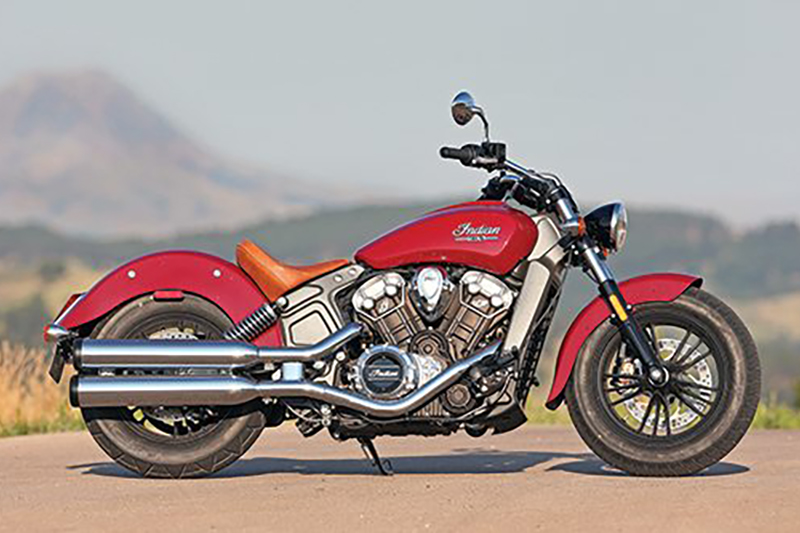2015 Indian Scout

First Ride Review
Before the Chief there was the Scout. The Chief may have been Indian’s stylistic high-water mark, but the Scout was its engineering masterpiece. Designed by racer-turned-engineer Charles B. Franklin and introduced in 1920, the Scout was powered by a 600cc (37ci) side-valve, semi-unit V-twin with twin cams and a gear-driven primary bathed in oil (enlarged to 61ci, the engine went on to power the Chief). The engine was mounted in a double-loop cradle frame that offered handling far better than any other motorcycle of the day. Scouts defied gravity on the Wall of Death, transported Allied servicemen during World War II, dominated racing in the hands of the Wrecking Crew and shattered land-speed records in the hands of Burt Munro.
Just a year after the reborn, Polaris-owned Indian reintroduced the Chief, the Scout is back—the first new Indian to carry the legendary name in more than 70 years. And it’s back with a vengeance, packing a liquid-cooled, 1,133cc (69ci) 60-degree V-twin with DOHC and four valves per cylinder. Indian says the all-new engine makes 100 horsepower at 8,100 rpm and 72 lb-ft of torque at 5,900 rpm, revving out to a very uncruiserlike 9,000-rpm redline. Its 10.7:1 compression ratio and throttle-by-wire aren’t usual cruiser fare, either. Vestiges of bygone Scouts can be seen in the engine, but its modern, mechanical styling tells even a casual bystander that this bike means business.
Due to a scheduling conflict, I didn’t make it to the Scout’s coming-out party. By showing up two days late to the Sturgis Motorcycle Rally, I missed the flashy unveiling and official press ride. Lucky me. Instead of a 100-mile, conga-line ride with other journalists, I got a solo, all-access pass on a Scout, racking up nearly 600 miles in two days, from Devils Tower to the Badlands and many points in between. I rode it hard and put it away wet—literally, because it rained…a lot—treating it more like a café racer than a cruiser (and yes, it will do the ton and then some). The high-revving, belt-driven Scout begs to be given the whip, shifting through its six gears with the greatest of ease. Tootle around town until your heart’s content, or wick it up; above 5,000 rpm—the point at which most cruisers tap out—the Scout really comes alive. I had so much fun that I tried to overlook the fact that its counterbalanced engine felt too smooth, its exhaust note too dull. I longed for some snarl, a bit more soundtrack for my own private action flick.
With a long 29-degree rake and lay-down rear shocks, the Scout’s long-and-low chassis layout echoes the “rigid triangle” design of its ancestors. Despite that chunky 130-series front tire, it has responsive handling, aided and abetted by a strong-but-light cast aluminum frame, a claimed 558 soaking-wet pounds carried low and a 150-series rear tire. I used every bit of the Scout’s 31 degrees of lean angle and went home with beveled boot heels. The bike’s biggest limitations are just 3 inches of rear suspension travel and underwhelming power from the two disc brakes (ABS is not available).
At 6-foot, 2-inches, I’m a bit long of limb for the Scout. The reach to the bars was fine, but putting my feet on the forward-set pegs forced me into a knees-above-hips posture. The Desert Tan leather solo seat was firm and supportive, but the seating position became uncomfortable after a half-hour or so. Straightening my legs and resting them on the pegs provided welcome relief for my joints and contact points. Indian says the Scout is designed to accommodate riders ranging in height from 5-foot, 4-inches to 6-feet-even, but with reduced- and extended-reach accessory seats, handlebars and foot controls, riders up to 4 inches shorter or taller should fit comfortably. The only thing to obstruct the rider’s view is a solitary analog speedo perched atop the handlebar. It has an inset digital display that can be toggled through various functions (tachometer, tripmeter, odometer, engine temperature). There’s a clock but no fuel gauge, just a low-fuel light.
Easy to lift off the kickstand and narrow between the knees, the Scout feels compact but by no means diminutive. It looks and feels solid, the sculpted gray frame providing muscular support for the black-and-silver engine. Squared-off downtubes outline and partially conceal the radiator—often the most awkward styling feature on liquid-cooled cruisers. The shapely fuel tank holds just 3.3 gallons of premium (I averaged 43 mpg even though I gave the throttle a serious workout). Dual chrome pipes provide contrast for the many blacked-out parts, such as the cast 16-inch wheels, fork tubes and throwback headlight nacelle. The rear fender looks bigger than it ought to because it’s designed to carry a passenger with the addition of an accessory pillion seat and footpegs. Other accessories include a luggage rack, leather saddlebags, rider and passenger backrests, and quick-release windshields in three heights.
The folks at Polaris Industries take their stewardship of the Indian brand very seriously. With the Chiefs and now the Scout, they’re honoring the past without living in it. This ain’t your granddaddy’s Scout, nor is it the Scout that anyone saw coming. It snuck up on us, blazing a new trail in terms of styling and performance, going well beyond its legendary name to show us what the future of cruisers might look like. And the future is within reach: $10,999 for Thunder Black or $11,299 for Indian Motorcycle Red, Silver Smoke or Thunder Black Smoke.
